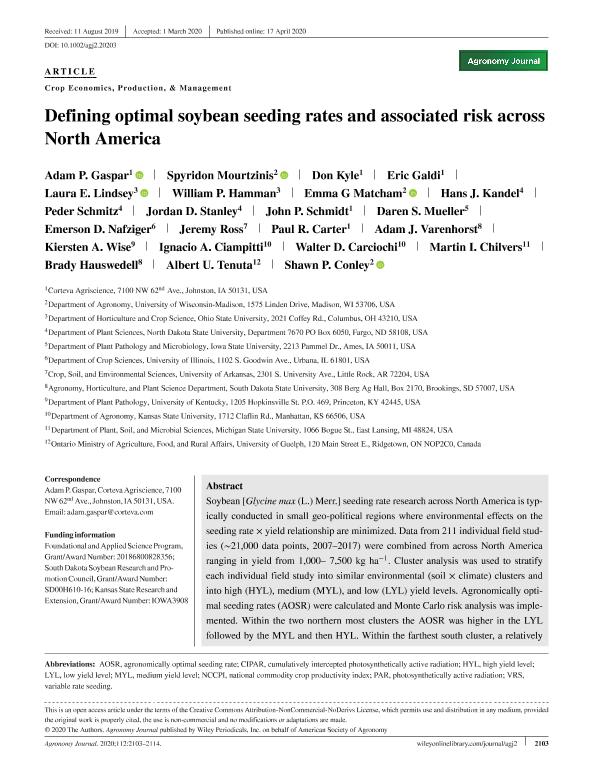Artículo
Defining optimal soybean seeding rates and associated risk across North America
Gaspar, Adam P.; Mourtzinis, Spyridon; Kyle, Don; Galdi, Eric; Lindsey, Laura E.; Hamman, William P.; Matcham, Emma G; Kandel, Hans J.; Schmitz, Peder; Stanley, Jordan D.; Schmidt, John P.; Mueller, Daren S.; Nafziger, Emerson D.; Ross, Jeremy; Carter, Paul R.; Varenhorst, Adam J.; Wise, Kiersten A.; Ciampitti, Ignacio Antonio; Carciochi, Walter Daniel ; Chilvers, Martin I.; Hauswedell, Brady; Tenuta, Albert U.; Conley, Shawn P.
; Chilvers, Martin I.; Hauswedell, Brady; Tenuta, Albert U.; Conley, Shawn P.
 ; Chilvers, Martin I.; Hauswedell, Brady; Tenuta, Albert U.; Conley, Shawn P.
; Chilvers, Martin I.; Hauswedell, Brady; Tenuta, Albert U.; Conley, Shawn P.
Fecha de publicación:
05/2020
Editorial:
American Society of Agronomy
Revista:
Agronomy Journal
ISSN:
0002-1962
e-ISSN:
1435-0645
Idioma:
Inglés
Tipo de recurso:
Artículo publicado
Clasificación temática:
Resumen
Soybean [Glycine max (L.) Merr.] seeding rate research across North America is typically conducted in small geo-political regions where environmental effects on the seeding rate × yield relationship are minimized. Data from 211 individual field studies (∼21,000 data points, 2007–2017) were combined from across North America ranging in yield from 1,000– 7,500 kg ha−1. Cluster analysis was used to stratify each individual field study into similar environmental (soil × climate) clusters and into high (HYL), medium (MYL), and low (LYL) yield levels. Agronomically optimal seeding rates (AOSR) were calculated and Monte Carlo risk analysis was implemented. Within the two northern most clusters the AOSR was higher in the LYL followed by the MYL and then HYL. Within the farthest south cluster, a relatively small (±15,000 seeds ha−1) change in seeding rate from the MYL was required to reach the AOSR of the LYL and HYL, respectively. The increase in seeding rate to reach the LYL AOSR was relatively greater (5x) than the decrease to reach the HYL AOSR within the northern most cluster. Regardless, seeding rates below the AOSR presented substantial risk and potential yield loss, while seeding rates above provided slight risk reduction and yield increases. Specific to LYLs and MYLs, establishing and maintaining an adequate plant stand until harvest maximized yield regardless of the seeding rate, while maximizing seed number was important with lower seeding rates. These findings will help growers manage their soybean seed investment by adjusting seeding rates based upon the productivity of the environment.
Palabras clave:
North America
,
Soybean
Archivos asociados
Licencia
Identificadores
Colecciones
Articulos(CCT - MAR DEL PLATA)
Articulos de CTRO.CIENTIFICO TECNOL.CONICET - MAR DEL PLATA
Articulos de CTRO.CIENTIFICO TECNOL.CONICET - MAR DEL PLATA
Citación
Gaspar, Adam P.; Mourtzinis, Spyridon; Kyle, Don; Galdi, Eric; Lindsey, Laura E.; et al.; Defining optimal soybean seeding rates and associated risk across North America; American Society of Agronomy; Agronomy Journal; 112; 3; 5-2020; 2103-2114
Compartir
Altmétricas



